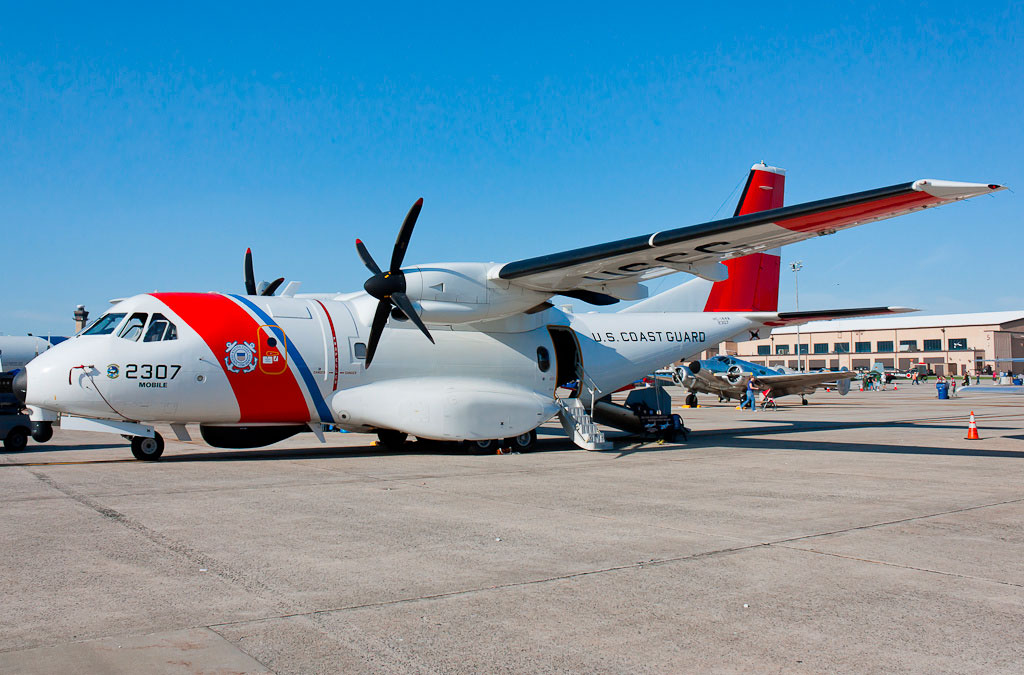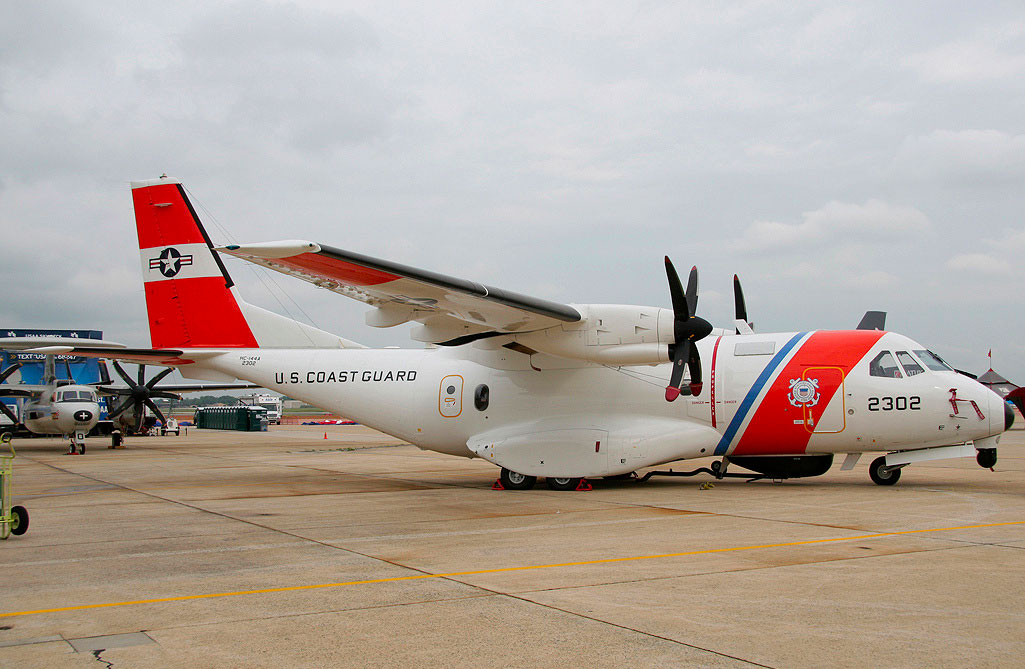Airbus Military HC-144 Ocean Sentry: a twin-engine turboprop for maritime patrol, optimized for search and rescue (SAR) missions.
In brief
The HC-144 Ocean Sentry, developed by Airbus Military (formerly EADS CASA), is a medium-range maritime patrol aircraft used by the U.S. Coast Guard. Derived from the CN-235-300M platform, it features two General Electric CT7-9C3 turboprop engines that allow a top speed of 230 knots (265 mph or 426 km/h) and an operational range of 2,000 nautical miles (3,704 kilometers). With a crew capacity of five, including pilots and mission crew, the HC-144 excels in SAR, law enforcement, and environmental protection roles. Its modular cabin configuration and advanced C4ISR (Command, Control, Communications, Computers, Intelligence, Surveillance, and Reconnaissance) suite enable versatile mission capabilities. The aircraft boasts STOL (Short Take-Off and Landing) capabilities, making it ideal for operations from smaller, unpaved runways, which is advantageous for coastal and overwater patrols.

The Airbus Military HC-144 Ocean Sentry
The Airbus Military HC-144 Ocean Sentry serves as a crucial asset in the U.S. Coast Guard’s Medium Range Surveillance fleet. Developed as a successor to the aging HU-25 Guardian, the HC-144 was selected in the early 2000s to enhance maritime patrol capabilities. This aircraft, tailored specifically for the demands of the Coast Guard, provides multi-mission flexibility and an extensive range, making it ideal for SAR, drug interdiction, and maritime surveillance missions. Its adaptability allows it to perform various roles with different payloads, making it a cornerstone of the Coast Guard’s aerial assets. Since achieving initial operational capability in 2009, the HC-144 has become an integral part of the Coast Guard’s operations, with deployments across the United States.
History of the Development of the Airbus Military HC-144 Ocean Sentry
The development of the HC-144 Ocean Sentry began in response to the U.S. Coast Guard’s need for a reliable, medium-range maritime patrol aircraft to replace the Dassault HU-25 Guardian. By the early 2000s, the Coast Guard required an aircraft that could fulfill multiple roles, from SAR and homeland security missions to environmental monitoring. Airbus Military offered the CN-235-300M Persuader as the basis for the HC-144, a proven platform already in use by various nations for maritime patrol and surveillance.
The HC-144 made its first flight in 2006 and was officially introduced to the Coast Guard’s fleet in 2009. It is part of the Deepwater program, an extensive modernization initiative aimed at revitalizing the Coast Guard’s aerial and maritime capabilities. The HC-144 was designed with a focus on versatility and durability, suitable for operations in diverse environments. Although it does not carry a NATO nickname, the HC-144 has been nicknamed “Ocean Sentry” due to its role in maritime vigilance.
Design of the Airbus Military HC-144 Ocean Sentry
The HC-144 is a high-wing, twin-engine turboprop aircraft, with a rugged design well-suited to maritime environments. The aircraft measures 70.2 feet (21.4 meters) in length, with a wingspan of 84.7 feet (25.8 meters) and a height of 26.8 feet (8.2 meters). Built on the CN-235 platform, it retains the short-field performance capabilities of its predecessor, allowing it to operate from smaller airfields. This STOL capability is critical for missions that require flexibility in terms of takeoff and landing.
Powered by two General Electric CT7-9C3 turboprop engines, the HC-144 can carry out missions at speeds up to 230 knots (265 mph or 426 km/h) and can cruise for extended periods with a maximum range of 2,000 nautical miles (3,704 kilometers). The aircraft’s modular cabin allows for easy reconfiguration, accommodating up to 40 passengers, or equipment for SAR and environmental missions. Additionally, the aircraft’s advanced C4ISR suite enhances its operational effectiveness by providing comprehensive surveillance and communication capabilities.
Performance of the Airbus Military HC-144 Ocean Sentry
The HC-144 Ocean Sentry is designed to excel in medium-range maritime patrol operations, thanks to its efficient turboprop engines and robust airframe. The aircraft’s CT7-9C3 engines generate 1,870 shaft horsepower each, enabling a maximum speed of 230 knots (265 mph or 426 km/h) and a service ceiling of approximately 25,000 feet (7,620 meters). With a range of 2,000 nautical miles (3,704 kilometers) and an endurance of up to 10 hours, the HC-144 is well-suited for prolonged missions over water.
In terms of performance, the HC-144’s low-speed handling and stability give it an edge in SAR operations. While it may not reach the speeds of jet-powered competitors like the Boeing P-8 Poseidon, its fuel efficiency and operational range provide a cost-effective alternative for medium-range patrol. Its C4ISR suite offers real-time surveillance and coordination capabilities, essential for managing SAR and enforcement missions effectively.
Variants of the Airbus Military HC-144 Ocean Sentry
The primary variant of the HC-144 is the HC-144A, used extensively by the U.S. Coast Guard. Another variant, the CN-235-300M Persuader, is utilized by other nations for similar maritime patrol duties. While the HC-144A is specialized for U.S. Coast Guard operations, including SAR and drug interdiction, the CN-235-300M features similar capabilities tailored to the requirements of other users. There are no major design differences between these variants, as both share the same airframe and propulsion system.
The Coast Guard has also explored integration with other systems, such as the C-27J Spartan, to enhance operational capacity alongside the HC-144. Although no significant variants beyond the HC-144A have been produced, the airframe’s adaptability allows it to fulfill a range of mission profiles with minimal modification.

Military Use and Combat of the Airbus Military HC-144 Ocean Sentry
The HC-144 Ocean Sentry has been deployed in various operational scenarios by the U.S. Coast Guard, focusing on SAR, law enforcement, and environmental monitoring. Though unarmed, the HC-144 plays a vital role in non-combat support missions. It has been involved in notable operations, such as disaster relief efforts during the 2010 Haiti earthquake and the Deepwater Horizon oil spill. These missions highlighted the HC-144’s value as an on-scene command platform, equipped with communications and coordination systems that enhance response efforts.
Its modular design allows the HC-144 to carry SAR equipment, including life rafts and emergency supplies, which can be deployed mid-air. The aircraft also supports anti-drug operations, utilizing its radar and surveillance capabilities to track and intercept vessels suspected of trafficking. The HC-144’s endurance and range enable it to conduct extended patrols along coastlines and over open waters, proving invaluable for homeland security missions. Currently, the HC-144 is exclusive to the U.S. Coast Guard, with no exports to other countries.
Back to the Special Aircraft section